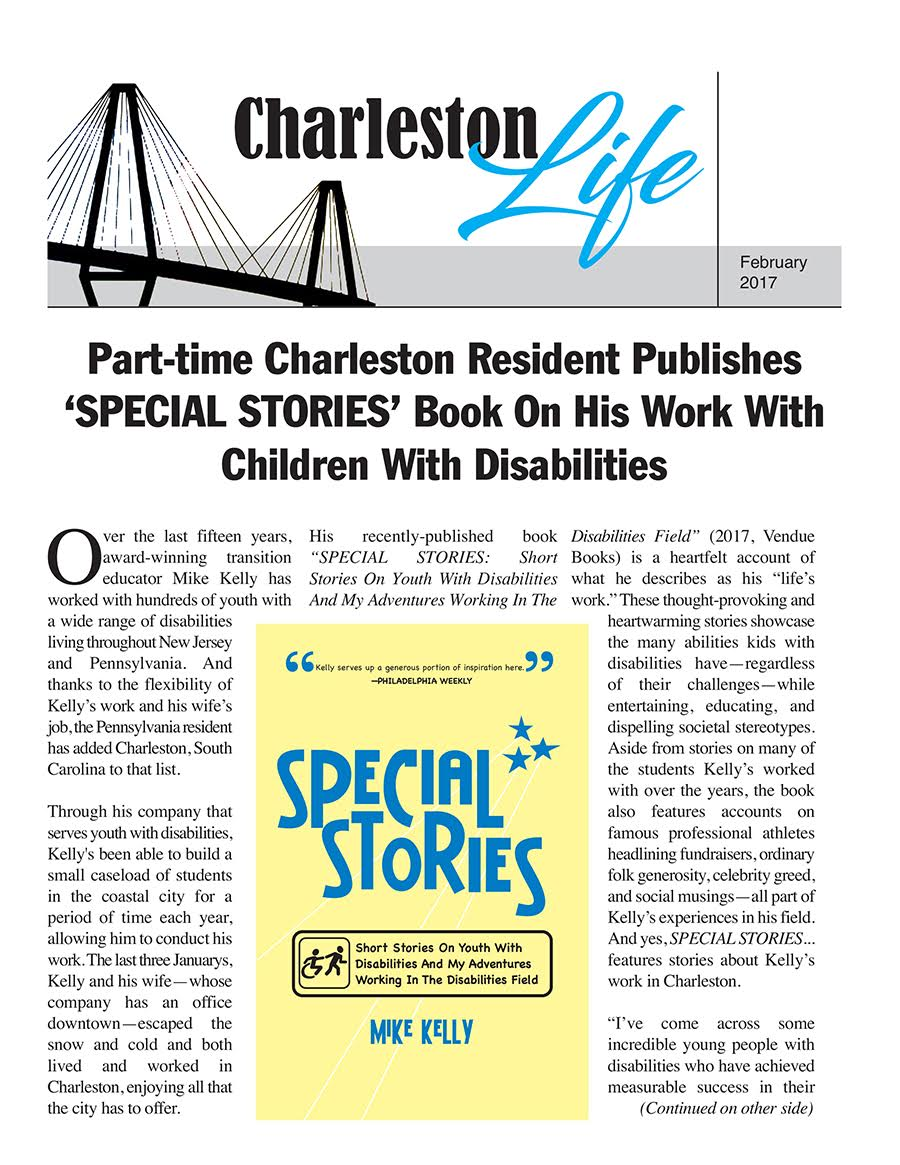Book featuring children with intellectual disabilities- Teen with disabilities is budding artist- Part 1 of 2
PART 1
Due to the flexibility of my job and my wife’s work—combined with our desire to travel and embark upon new adventures—I was able to build a small caseload of students in Charleston, South Carolina each winter. During my work in the historic and charming Southern city, I was privately hired by parents who wanted me to help their fifteen-year-old daughter named Lindsay (not her real name) enter the workforce. After not having any luck themselves locating work for their daughter, they came across my business and sought my assistance.
Tall and gangly with medium length brown hair and hazel eyes, Lindsay is as cute as a button and sweeter than Charleston sweet tea. She has intellectual challenges as well as epilepsy, and suffers from absence seizures (formerly known as petit mal). These types of seizures are due to abnormal activity in her brain, cause a blanking out, and provide no predictors to warn when they will come.
With limited volunteer experience and no prior paid work history, Lindsay told me during her intake that she’s an artist and enjoys making hand-made bracelets, necklaces, earrings and other adornments to be worn using beads, faux leather and other materials. But she said that her real love is to paint watercolors and oils—mostly scenes of the historic homes where she lives downtown. Her face illuminated when she told me this. Lindsay’s goal was to work in the world-famous Charleston City Market—aka The Market—an historic complex of buildings that is Charleston’s top tourist attraction.
Built in 1804, The Market houses scores of artists and craftspeople who sell authentic Charleston art, souvenirs and collectibles of all types. Lindsay said that she enjoys the hustle and bustle of The Market, and the wide array of items sold there, and wants to be part of that cool scene.
I had my work order. Despite her intellectual and epileptic challenges, I was confident that I could help Lindsay do something that she’d like, and within The Market.
After collaborating with Lindsay to create her resume, I had Lindsay accompany me to network at The Market and pass out copies. Because of her calm demeanor and easy-going personality, I knew that I’d increase my chances of locating her work if she were with me. Luckily, it wasn’t too long before Lindsay was hired for pay by a thirty-something artist named Carly (not her real name), who’d been displaying her artwork at The Market for a few months. Carly was apprised of my student’s medical condition, had some concerns, asked some questions, and eventually welcomed Lindsay with open arms. Lindsay’s job three days a week was to help unload paintings from Carly’s van, carefully set them up on the display tables, interact with prospective customers, and pass out cards to passersby. Lindsay would also keep watch over the table during moments when Carly had to momentarily leave. At the end of her shift, Lindsay would carefully break down the display, help pack up, and place everything neatly back into Carly’s van.
The first week I intensively job coached Lindsay and she acclimated well. The second week, I gradually reduced my job coaching as she was making more progress. By week three, I periodically checked in on her while she worked her 4-hour shifts. By the fourth week, Lindsay was completely independent—save for her natural workplace support, Carly.
After work each day during the last week when I provided supported employment assistance to Lindsay, as a reward for a successful transition into her job, Lindsay and I would walk over to either King Street Cookies—where she’d have two ginger snaps and a cup of milk, or over to Kaminsky’s—where we’d both indulge in one of their famous desserts. Whichever place she chose, it was always my treat.
The entire experience was a textbook example of how this process should work. Parents and student needed help and privately hired me to provide it. Artist needed part-time assistance selling her artwork and found it in a young, fellow artist willing to help.
During her time working for Carly, Lindsay only had one seizure. Carly stayed calm and took charge of the matter, and Lindsay was on her feet and back to work in just a few minutes.
As I returned to Pennsylvania to continue my work there, I knew that Lindsay was in good hands working for Carly at her booth within The Market.
While much of my work is conducted behind-the-scenes and often deals with rejection, frustration, and constant obstacles, having worked with Lindsay and her wonderful parents, I realized just how blessed I am to be in my chosen line of work. The cherry on top of that life’s work is when I meet open-minded and receptive people like Carly who give my students a chance in life—regardless of my student’s challenges.
And, in the case of this particular student, I’m triply blessed to be able to work in one of the most beautiful cities on the planet in Charleston, South Carolina. If you haven’t been there yet, go. You’ll love the restaurants, the people, and the city. Travel magazines always rank it among the top destinations to visit within the U.S.
Each time I return home, I leave a little piece of my heart in that magical little city.
To read more stories about kids with disabilities or for more information on SPECIAL STORIES: Short stories on youth with disabilities and my adventures working in the disabilities field, visit www.specialstoriesbook.com.

